Hops in Beer Brewing: Banner
Published: October 4, 2025 at 12:28:18 PM UTC
Banner hops were developed in the U.S. from a Brewers Gold seedling through open pollination in the early 1970s. They were released in 1996, thanks to Anheuser-Busch's interest. Initially, they were bred for bittering, but they soon became popular in both large-scale and craft brewing. Banner hops are known for their high-alpha content, typically around 11%. They are favored for their ability to efficiently add bitterness and stability to beers. In many recipes, Banner hops make up about one-third of the total hop additions. This makes them a go-to choice for brewers aiming for precise bitterness.
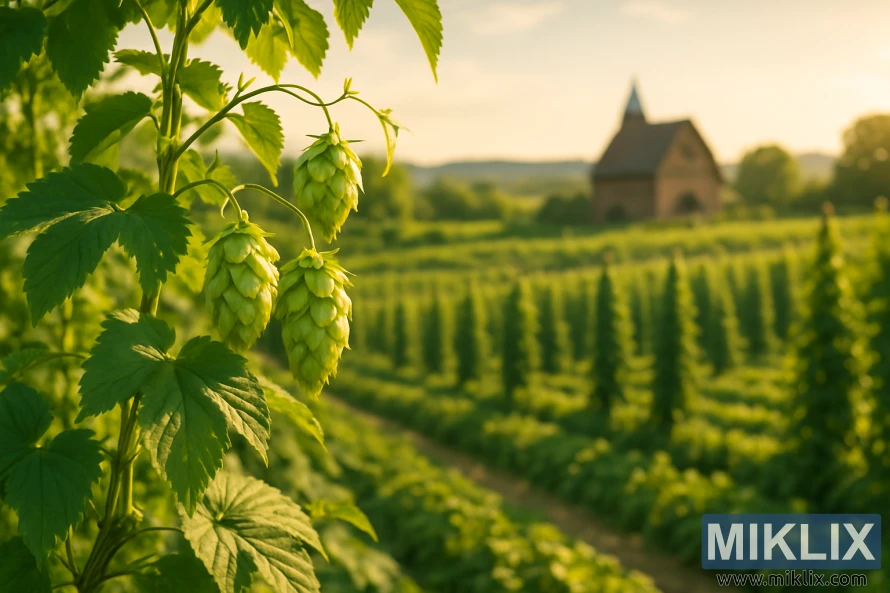
It's important to note that the term "banner" in the marketplace refers to graphic banners, not the hop variety. This article is dedicated to exploring Banner hops in the context of beer brewing and craft brewing.
Key Takeaways
- Banner hops are an American high-alpha variety released in 1996.
- They were bred from Brewers Gold and aimed at bittering use.
- Alpha acids around 11% make Banner efficient for IBU control.
- Banner often represents about 33% of total hop additions in recipes.
- This article addresses the Banner hop variety, not graphic banners.
What are Banner hops and their origin
Banner hops are an American-bred variety, developed from Brewers Gold through open pollination in the early 1970s. The goal was to create a reliable bittering hop with high alpha acids for large-scale brewing. This was a significant step in hop cultivation.
The origin of Banner hops is rooted in the United States. It was commercially released after Anheuser-Busch adopted it in the 1990s. Known for its alpha-acid range of 10–12.7%, it became a favorite among brewers for its strong bitterness.
Banner hop history is marked by both promise and limitations. It offered high alpha acids and a pleasant aroma. Yet, it faced challenges with poor storage stability and susceptibility to common hop diseases. These issues led to a decline in its popularity among growers and suppliers.
It's important to distinguish Banner hops from other uses of the term "banner." The Brewers Gold descendant lineage is key to understanding Banner's role in modern brewing. This lineage highlights its significance in hop cultivation.
Botanical and geographic background of Banner hops
Banner, a cultivar of Humulus lupulus, was developed in the United States. It is registered under the international code BAN. Created from a Brewers Gold seedling through open pollination in the early 1970s, Banner's lineage connects it to classic bittering stock used in American brewing.
The origins of Banner trace back to U.S. hop regions. During the postwar era, commercial yards experimented with new selections. Growers in Washington and Oregon evaluated Banner alongside other U.S. hop varieties for yield and alpha-acid potency. Trials showed its suitability for domestic brewing needs at the time.
Botanically, Banner shares traits with other high-alpha cultivars but has notable vulnerabilities. It proved susceptible to common fungal diseases and showed limited post-harvest stability. These weaknesses led to a decline in its acreage as brewers and farmers turned to more robust U.S. hop varieties.
Despite its decline, Banner hop botany remains relevant to breeders and historians. Seed records and trial data preserve its place in breeding programs. These programs have produced many contemporary American aroma and bittering hops.
- Parentage: Brewers Gold seedling via open pollination.
- Origin: United States, early 1970s development.
- Limitations: Disease susceptibility and poor storage stability.
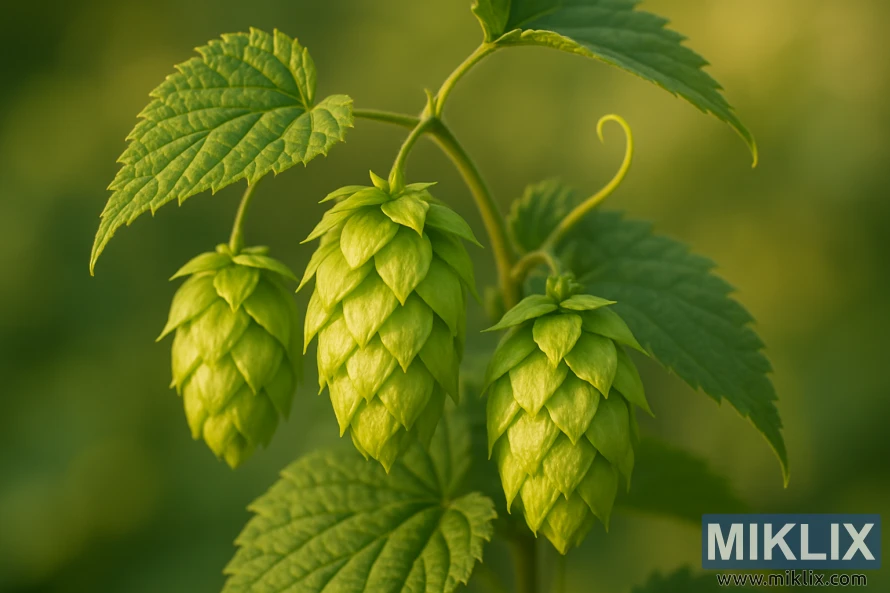
Chemical composition and brewing values
Banner is classified as a high-alpha bittering hop. Historical data indicate Banner hop alpha acid values range from 8.4% to 13.1%. Most sources cluster around 10.8%. A more detailed dataset reveals typical ranges between 10.0% and 12.7%.
Banner beta acids show greater variation. One dataset reports beta values near 5.3%–8.0% with an average of 6.7%. Reports also mention a single-year beta as low as 4.0%, emphasizing seasonal and crop variations.
- The alpha-to-beta ratio often falls between 1:1 and 2:1, with an average near 2:1.
- Co-humulone Banner is typically around 34% of total alpha acids, influencing perceived bitterness.
- Total hop oils are modest, about 2.17 mL per 100 g, contributing less to aroma than many aroma-focused varieties.
Brewers mainly use Banner for bittering. It is typically used in about one-third of total hop additions. For IBU calculations, use the higher end of Banner hop alpha acid ranges for conservative estimates.
Hop stability is a concern. The hop storage index Banner is around 57% (0.57), indicating poor shelf stability. Expect significant loss of alpha and beta acids after six months at room temperature. Store hops cold and use fresher lots for consistent results.
When substituting or blending, consider co-humulone Banner and modest oil content. Adjust quantities and late-hop aroma additions to maintain balance in the final beer.
Flavor and aroma profile of Banner hops
Banner is renowned for its role as a bittering hop. Its high alpha acids provide clean, straightforward bitterness. Historically, brewers have used Banner for its firm IBUs, rather than for its citrus or floral notes.
Growers report a pleasant but modest aroma from Banner hops. The total oils are moderate, near 2.2 mL/100g. This limits its contribution to late-boil or whirlpool additions. Thus, caution is advised when using Banner for aroma, aiming for a pronounced hop character.
In early kettle additions, Banner's flavor is reserved. It lends balance without overshadowing other flavors. This makes it ideal for traditional ales and lagers, where bitterness supports malt without competing with yeast esters or specialty malts.
Brewers seeking to enhance hop scent can pair Banner with varieties known for strong terpene and myrcene presence. This approach preserves the bittering hop profile while adding distinct top notes from aroma-focused hops.
- Primary role: kettle bittering for steady IBUs.
- Banner hop flavor: mild, clean, and supportive.
- Banner hop aroma: pleasant but not dominant.
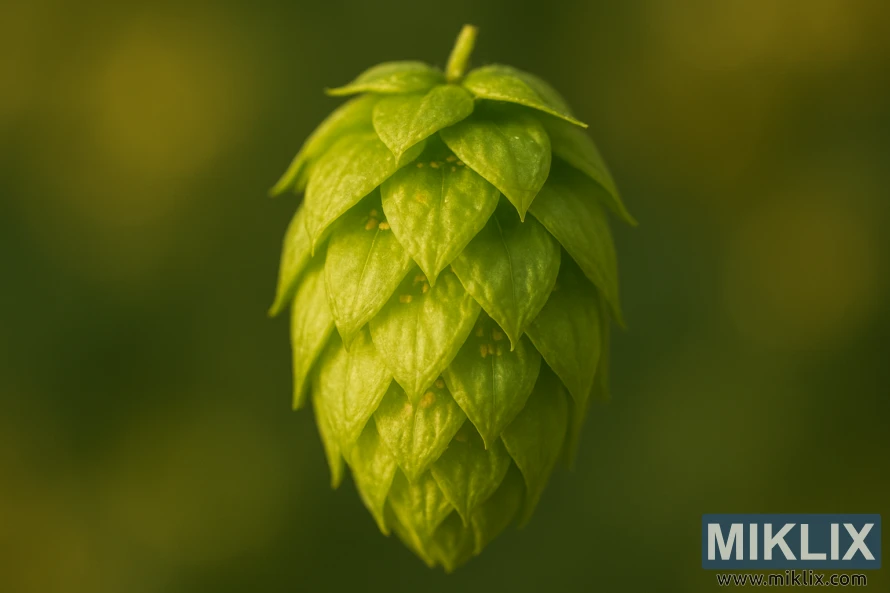
Brewing uses and best practices for Banner hops
Banner hops are mainly used for bittering. They should be added in the first 60–90 minutes of the boil. This allows for clean isomerization of alpha acids. For most ales and lagers, adding Banner early helps build a firm backbone.
Historical recipes often used Banner for about one-third of the total hop bill. This approach works well in multi-hop recipes. Here, one hop handles bittering, while others provide aroma. If you're wondering how to use Banner hops, think of it as the reliable bittering anchor, not the primary aroma source.
Limit late whirlpool additions and avoid heavy dry-hopping with Banner. Its modest total oil content and reduced aroma stability mean citrus and floral notes will be muted. Pair Banner with expressive aroma varieties like Amarillo, Cascade, or Citra to enhance the sensory profile.
- Use Banner for early boil bittering at standard alpha-acid adjustment rates.
- Target roughly 30–35% of hop mass from Banner in multi-hop bills for balanced bitterness.
- Reserve late additions for hops chosen for volatile oils and bright aroma.
Since Banner is no longer widely produced, plan substitutions or locate remaining fresh stocks carefully. Stale hops suffer from HSI-related degradation, lowering bittering efficiency and aroma. When sourcing, verify harvest dates and storage conditions to preserve performance during Banner hop bittering.
Follow Banner brewing best practices by measuring IBUs with the specific alpha-acid percentage you have on hand. Adjust grain and mash schedules to complement Banner’s clean bitterness. Small recipe trials help dial in the balance before scaling to larger batches.
Beer styles that historically used Banner hops
Banner was created as a high-alpha, neutral bittering hop for large-scale brewing. Its clean bitterness made it perfect for pale, crisp lagers brewed in the United States during the mid-20th century.
American lager Banner is often found in historic brewery logs and recipe databases. Anheuser-Busch, among others, preferred Banner for its steady alpha acid levels and predictable bittering in mainstream lagers.
Recipe collections show Banner used mainly as a bittering hop across various beer styles. Many recipes list Banner in early boil additions for bitterness, not late additions for aroma.
Typical Banner hops beer styles include:
- Classic American lager and light lager, where neutral bittering supports clean malt and yeast character.
- Pilsner-style lagers that require a restrained hop profile with reliable alpha acids.
- Bittering roles in some export lagers and session beers that prioritize drinkability over hop aroma.
Historical beers using Banner focused on scale and consistency, not hop-forward flavor. Brewers chose Banner for early kettle additions to achieve predictable IBUs without strong floral notes.
Today, craft brewers rarely pick Banner for aroma-forward ales. It remains relevant in mid-century American lager recreations and recipes needing neutral bittering hops to highlight malt and fermentation character.
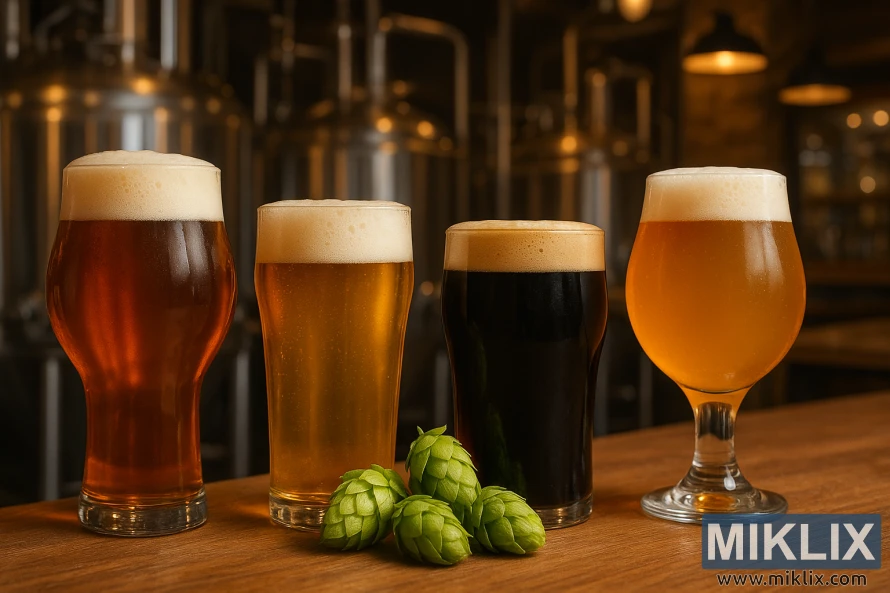
Dosage guidelines and recipe placement
Banner hops are known for their bittering prowess, with alpha acids ranging from 10–12.7%. This makes them a staple in many recipes, often accounting for about one third of the total hop weight. For a 5-gallon American pale ale, start with roughly 0.5–1.0 ounces at 60 minutes to reach target IBUs.
Early-boil additions are where Banner shines. The long boil times enhance alpha-acid isomerization, maximizing bittering efficiency. It's best to use 60-minute or equivalent bittering timings, rather than treating Banner as a late aroma hop.
Due to its modest total oils, late additions of Banner yield limited aroma lift. To achieve hop perfume, consider pairing a short-boil Banner bittering addition with late additions of high-oil varieties like Cascade or Citra. This approach maintains balanced bitterness while enhancing aroma from other hops.
When working with older hops, increase the dosage. Banner's HSI can be around 57% in less-than-ideal storage. Plan a slightly higher Banner hop dosage or verify actual alpha by lab or supplier certificate. Prioritize fresh pellets or whole cones and update calculations with measured alpha values.
- Typical bittering: 60-minute addition; use Banner for base IBUs.
- Late additions: limit reliance on Banner for aroma; expect modest oil contribution.
- Dry-hop: Banner is not ideal as the sole dry-hop; combine with aromatic varieties if desired.
For recipe scaling, apply standard IBU math and treat Banner similar to other high-alpha bittering hops. Recalculate amounts if alpha readings differ from the 10–12.7% range. Clear documentation of Banner recipe placement and measured alpha will reduce guesswork and help brewers hit consistent bitterness targets.
Substitutes for Banner hops
When a recipe calls for Banner and the supply is tight, pick bittering hops with a similar alpha acid range. Aquila, Cluster, and Galena are often recommended as substitutes. They fulfill Banner’s bittering role while maintaining balance in recipes.
Aquila is ideal for lagers and pale ales, offering steady, clean bitterness. Cluster is great for traditional American styles, adding a rounded, slightly spicy flavor. Galena provides firm bitterness and a hint of dark fruit, perfect for darker bitters and robust porters.
Brewers seeking concentrated bittering or enhanced lupulin impact might consider lupulin products from Yakima Chief Hops, BarthHaas, or Hopsteiner. Since no commercial lupulin version of Banner was widely released, these alternatives can offer similar potency in reduced weight.
- Aquila — reliable alpha range and clean bitterness; good for straightforward swap.
- Cluster — traditional American character, slightly spicy; fits many Banner recipes.
- Galena — high-alpha, firm bittering, subtle fruit; useful in darker beers.
For recipe swaps, replace Banner by adjusting alpha-acid content rather than mass. Calculate the bitterness target and scale the chosen alternative to match IBUs. Always test in small batches to refine the balance before scaling up.
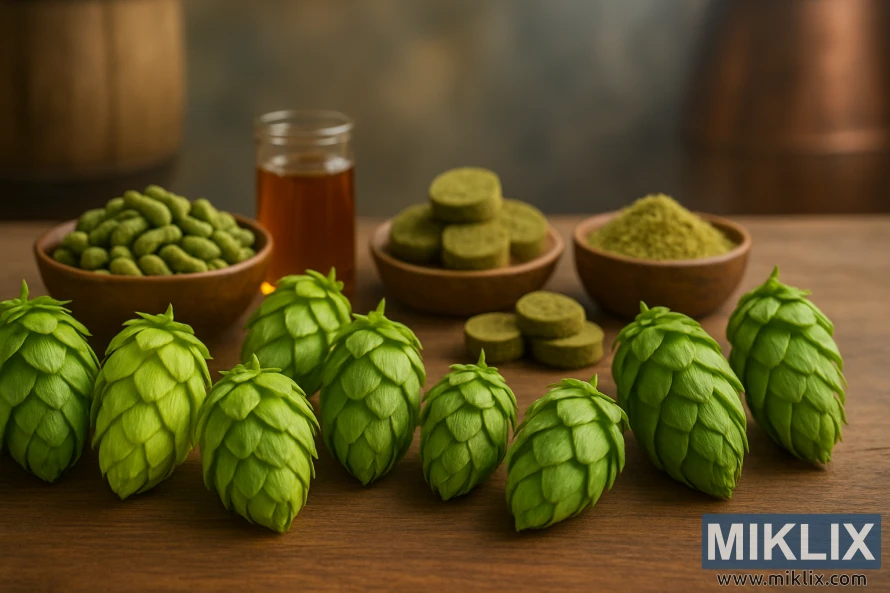
Compatibility and hop pairings
Banner is a clean bittering hop, best used early in the boil. This establishes a neutral backbone. It allows aroma hops to take center stage during late additions and dry hopping.
Popular choices for pairing with Banner include Amarillo, Cascade, and Citra. These American aroma hops introduce citrus, floral, and tropical notes. They enhance Banner's bittering role.
- Pairing Banner with Amarillo Cascade Citra in a single recipe brings bright orange and mango topnotes. Add those hops late to preserve aroma.
- Use Cascade for lemony lift in pale ales and pilsners that need crisp bitterness from Banner.
- Citra works well when you want grapefruit and tropical character over a steady bittering base.
For lagers or cleaner ales, Banner should be the primary bittering hop. Rely on aroma hops for complexity. Dry hop with Amarillo or Citra for a punchy nose without muddying bitterness.
Try these rough dosages: use Banner for 60–100% of early bittering additions. Reserve 10–40% of the hop bill for late Amarillo, Cascade, or Citra additions to achieve balance and aroma.
Storage, stability issues, and quality concerns
Banner hop storage necessitates adherence to cold-chain protocols. Data reveal that Banner hop HSI is approximately 57% (0.57) after six months at 68°F (20°C). This indicates significant degradation of alpha and beta acids. Brewers should anticipate that older inventory may not meet the expected bitterness levels.
Hop stability problems with Banner often arise from disease pressures during cultivation. Plants affected by powdery mildew or viral stress exhibit inconsistent cone formation. This inconsistency leads to variable alpha ranges across seasons, reducing the reliable commercial supply.
To address Banner stability issues, it is crucial to request recent crop analyses or conduct your own alpha-acid measurements before formulating. High HSI values indicate that measured alpha will decrease over time in storage. Thus, it is essential to plan bittering targets based on fresh test data.
- Store hops cold and vacuum-sealed to slow oxidation and alpha loss.
- Rotate stock fast; use the newest crop for bittering additions.
- Retest alpha acids when batches are older than three months.
Year-to-year fluctuations in both alpha and beta acids with Banner are expected. Some datasets show wide ranges, necessitating brewers to adjust dosages. Treat Banner as a variable ingredient rather than a fixed-value hop.
When sourcing, request lot certificates from suppliers like Yakima Chief or BarthHaas. Clear lab results help account for Banner hop HSI and support predictable IBU calculations. Proper Banner hop storage, combined with up-to-date analytics, minimizes surprises at the brew kettle.
Availability, purchasing, and forms sold
Banner hop availability is currently limited. Banner is no longer in active production. Stocks remain in legacy inventories at distributors and homebrew shops.
When you attempt to purchase Banner hops, expect variations in harvest year, alpha acid numbers, and price. It's crucial to check supplier lab data and inquire about storage history before making a purchase.
Traditionally, Banner was available in whole cone and hop pellets formats. Brewers could find these from leftover lots. Major processors like Yakima Chief Hops and BarthHaas did not produce cryo or lupulin powder forms of Banner.
Suppliers and marketplaces listed Banner intermittently. Availability varied by region and seller. Listings on Amazon and specialty hop merchants appeared when stock was available, then vanished as supplies were depleted.
- Buy Banner hops only after confirming freshness and COA details.
- Expect Banner hop pellets to be the easiest-to-store option if you plan multi-batch use.
- Banner whole cone appeals to small-scale and traditional brewers who value handling and aroma.
Price and lot size for legacy Banner vary widely. Small hobby packs and larger commercial quantities appear at different times. Verify year, weight, and testing data to align with your brewing goals.
Be aware that graphic or color “banner” products sold on stock marketplaces are unrelated to hop products. Focus on hop suppliers and established distributors for legitimate Banner hop availability.
Comparing Banner hops to other high-alpha bittering varieties
Banner's alpha acid, near 10.8–11%, places it in the high-alpha category alongside Galena, Cluster, and Aquila. Brewers will find Banner in many older recipes for its reliable IBUs and straight bittering character. This makes it a staple for those seeking consistent bitterness.
Comparing Banner to Galena, we note Galena's higher oil content and more assertive bitterness. Recipe data shows all three hops play similar bittering roles. Yet, Galena's firmer backbone is evident in late-kettle additions or whirlpool hops.
The comparison of Banner to Cluster is a staple in American brewing lore. Cluster is known for its toughness and ability to tolerate disease better. It offers steadier alpha levels across harvests, crucial for consistent bittering.
When comparing Banner to Aquila, we see differences in breeding and stability. Aquila, being newer, boasts improved resistance and tighter alpha ranges. This makes Aquila a better choice for predictable bitterness without the storage issues that limit Banner's shelf life.
Beyond alpha acids, Banner's co-humulone around 34% and total oils near 2.2 mL/100g shape its sensory impact. This profile yields moderate bitterness with limited aroma. A balanced high-alpha hop comparison must include these metrics to forecast its impact on mouthfeel and aftertaste.
Practical placement favors Banner for primary bittering additions. Historical recipe breakdowns show Banner's significant role in bittering charges, akin to Galena or Cluster in modern formulations. For a closer aromatic contribution, choose a high-alpha hop with higher oil content.
Storage and stability separate Banner from many modern bittering varieties. Banner's poorer HSI and disease susceptibility make it less robust over time. Newer high-alpha hops offer improved storage stability, disease resistance, and more consistent alpha readings. This reduces variability in mash pH and hop utilization.
Use this comparison checklist when choosing between these options:
- Alpha uniformity: Aquila and Cluster often win for consistent alpha across lots.
- Oil profile: Galena typically brings stronger oil levels for fuller bittering aroma.
- Field resilience: Cluster and Aquila generally outperform Banner on disease resistance.
- Recipe role: Banner serves well as a primary bittering hop in traditional formulations.
For a rounded high-alpha hop comparison, align your choice with desired stability, bitterness character, and aroma contribution. Each hop—Banner, Galena, Cluster, Aquila—offers a different balance of those traits for brewers drafting bittering schemas.
Practical recipe examples and historic use cases
Banner was a key bittering hop in large-scale lagers by Anheuser-Busch and other American breweries. Its high-alpha acids made it perfect for 60-minute additions. This ensured a neutral bitterness without overpowering aromas.
Archived brewing databases show 39 recipes that mention Banner. Most of these recipes use Banner early in the boil for consistent IBUs. Then, they add aroma hops late to shape the flavor.
Here are brief recipe sketches that reflect both historical and modern brewing practices. They aim for clarity and balance typical of American lagers and pale ales.
- Classic American lager (5.0% ABV): It starts with a Pilsner malt base. Use 1.0–1.25 oz of Banner for 60-minute bittering per 5 gal. For flavor, add 0.5 oz Amarillo at 10 minutes and 0.5 oz Cascade at flameout.
- Commercial-style pale lager (4.8% ABV): It combines pilsner and a small Vienna malt. Banner is used for clean bitterness at 60 minutes. Add 0.25–0.5 oz Citra at knock-out for a light citrus note.
- Bitter-forward amber lager (5.2% ABV): It uses Banner for bittering, with Cluster or Galena as substitutes. Add 0.5 oz Cascade late and 0.25 oz Amarillo as a dry-hop for aroma.
When Banner is hard to find, brewers use Galena or Cluster to recreate it. Adjust the rates for alpha differences and the hop storage index (HSI) to match expected bitterness.
Homebrewers aiming to recreate historic beers should focus on early additions of Banner. Pair it with aromatic hops like Amarillo, Cascade, or Citra later. This method keeps the classic neutral backbone while adding modern aroma accents.
- Tip: Calculate bittering by alpha acids, then reduce late-hop weight if substituting a higher-alpha variety such as Galena.
- Tip: Monitor HSI for older hop stock and boost or cut quantities to maintain consistency across batches.
These Banner hop recipes and examples show both historical use and practical steps for modern brewers. They highlight Banner's role in American lagers as a clean bittering hop.
Conclusion
Banner hops summary: Banner was a U.S.-bred hop, known for its high-alpha bittering. It descended from Brewers Gold and was introduced in the 1970s, released in 1996. With alpha values around 10–12.7%, it was a top pick for brewers aiming for clean bitterness. Anheuser-Busch showed early interest, but disease and poor storage stability led to its decline.
Banner hop takeaways for formulators are clear. Use Banner as a bittering hop and add it early in the boil. When looking for alternatives, Galena, Cluster, or Aquila are good choices. They offer similar alpha and bittering qualities without the storage and HSI issues of Banner.
Banner hop considerations are key for inventory and recipe planning. Check legacy stock for oxidation and alpha loss before use. For both new and experienced brewers, opting for modern, stable varieties is best. Adjusting additions to match Banner’s historical role ensures the desired bitterness without off-flavors or supply issues.
Further Reading
If you enjoyed this post, you may also like these suggestions:
